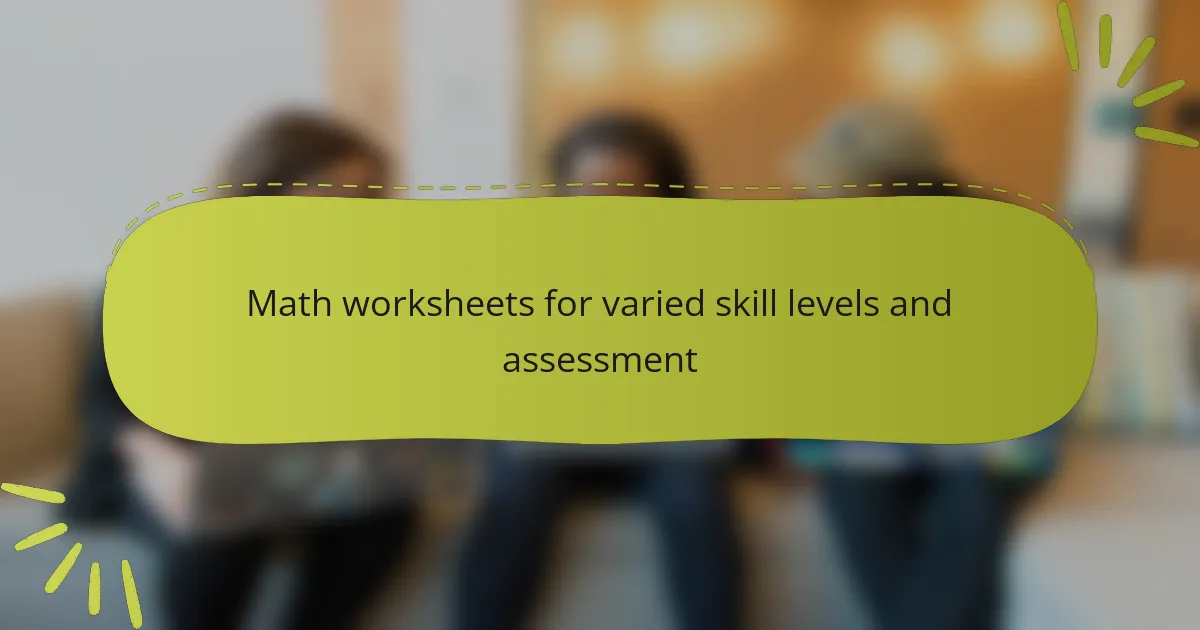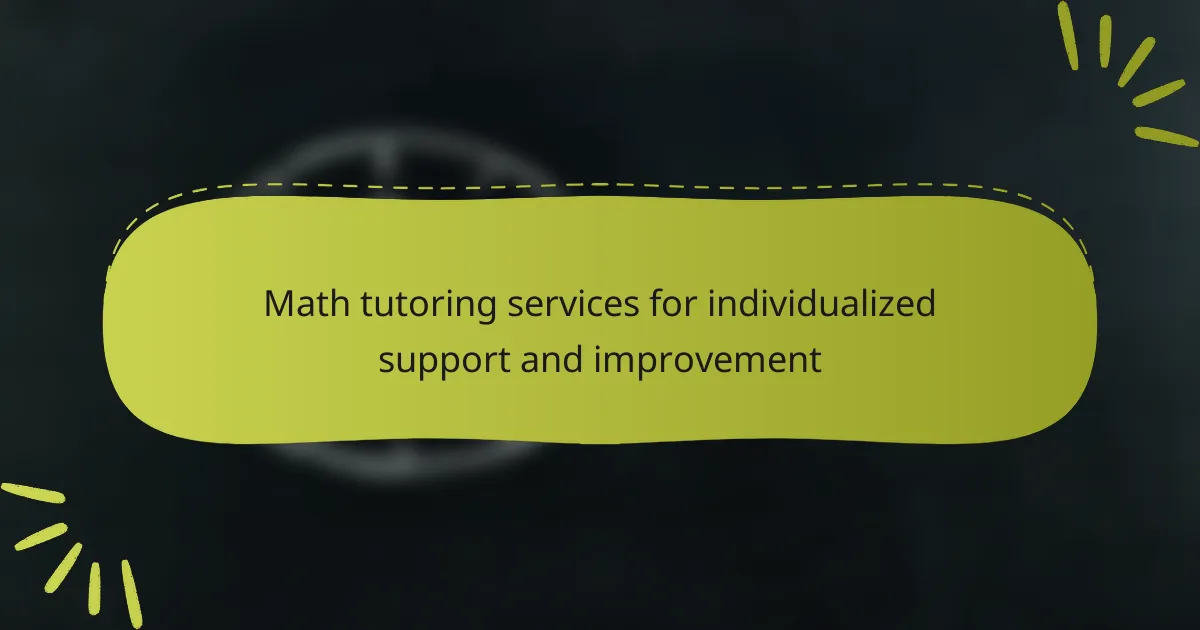Interactive math apps are digital tools designed to enhance math skills through personalized learning experiences. These applications offer features such as adaptive learning paths, instant feedback, and engaging activities, which cater to individual user needs. Popular examples include Khan Academy, Prodigy Math, and IXL, each adjusting difficulty based on user performance. Research indicates that personalized learning approaches, supported by technology, can significantly improve student engagement and academic outcomes in mathematics. The article will explore various types of interactive math apps, including problem-solving, educational games, visualization tools, adaptive learning, and collaborative platforms, highlighting their unique contributions to effective math learning.
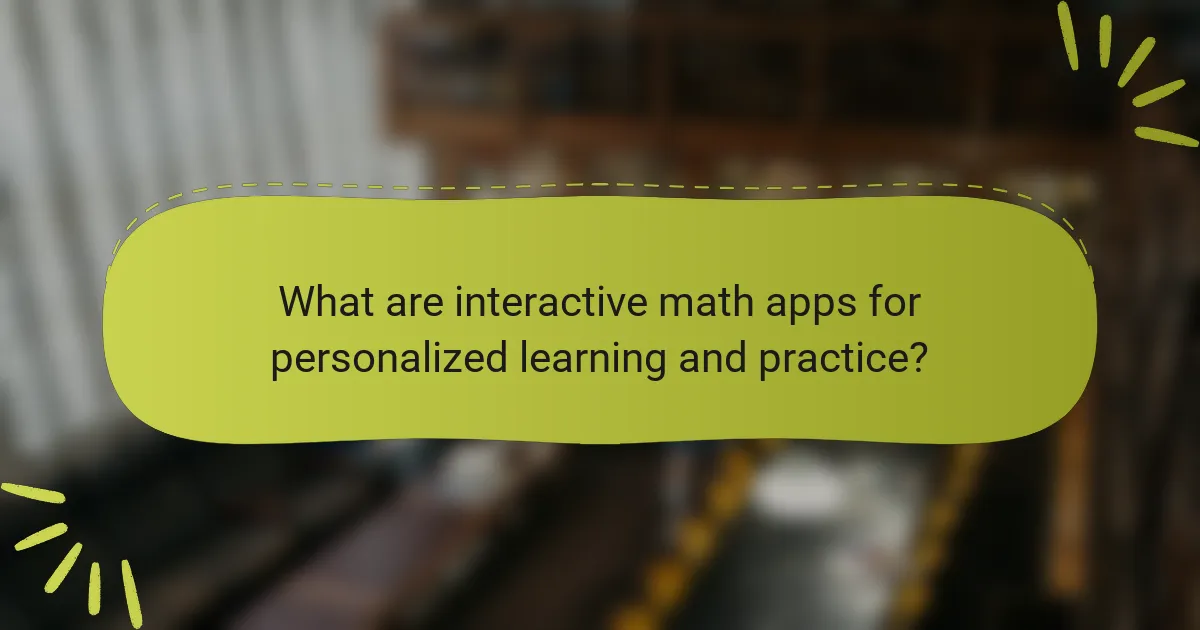
What are interactive math apps for personalized learning and practice?
Interactive math apps for personalized learning and practice are digital tools designed to enhance math skills. These apps provide tailored learning experiences based on individual user needs. They often include features like adaptive learning paths, instant feedback, and engaging activities. Popular examples include Khan Academy, Prodigy Math, and IXL. Each app adjusts difficulty based on user performance. Research shows that personalized learning can improve student outcomes significantly. A study by the Bill & Melinda Gates Foundation highlights that personalized learning approaches can lead to better engagement and understanding in mathematics.
How do interactive math apps enhance personalized learning?
Interactive math apps enhance personalized learning by providing tailored educational experiences. These apps adapt to individual learning styles and paces. They offer instant feedback on exercises, allowing learners to identify strengths and weaknesses. Data analytics within these apps track progress over time. This information helps educators adjust instruction accordingly. Research shows that personalized learning can improve student engagement and achievement. A study by the Bill & Melinda Gates Foundation found that personalized learning approaches can lead to significant gains in student performance. Thus, interactive math apps effectively support customized learning pathways.
What features make interactive math apps effective for personalized learning?
Interactive math apps are effective for personalized learning due to several key features. They provide adaptive learning pathways that adjust to individual student needs. These apps often include real-time feedback, allowing students to understand mistakes immediately. Gamification elements engage learners and motivate them to progress. Additionally, they offer a variety of problem types to cater to different learning styles. Analytics features track progress and identify areas for improvement. Customizable settings allow users to tailor the difficulty level. Finally, many apps incorporate multimedia resources to enhance understanding. These features collectively support personalized learning experiences in mathematics.
How do these apps adapt to individual learning styles?
Interactive math apps adapt to individual learning styles by utilizing personalized learning algorithms. These algorithms assess users’ strengths and weaknesses through initial assessments. Based on the results, the apps tailor content to suit different learning preferences. For example, visual learners receive more graphical representations of problems. Auditory learners benefit from verbal explanations and audio cues. Kinesthetic learners engage with interactive elements that require physical manipulation. Additionally, the apps often allow customization of difficulty levels, ensuring that each user progresses at their own pace. Research shows that personalized learning approaches enhance student engagement and retention. A study by the Bill & Melinda Gates Foundation found that personalized learning can lead to improved academic outcomes.
Why is practice important in learning math through apps?
Practice is important in learning math through apps because it reinforces understanding and retention of concepts. Engaging with math problems frequently helps learners identify patterns and develop problem-solving skills. Apps often provide instant feedback, allowing users to correct mistakes in real-time. This immediate response enhances the learning process and builds confidence. Research shows that spaced repetition, a technique often used in apps, improves long-term memory retention. A study by Cepeda et al. (2006) published in “Psychological Science” indicates that practice over time leads to better mastery of skills. Therefore, consistent practice through math apps is crucial for effective learning.
What types of practice can interactive math apps provide?
Interactive math apps can provide various types of practice, including problem-solving exercises, quizzes, and interactive games. These apps often focus on different mathematical concepts, such as arithmetic, geometry, and algebra. Users can engage in adaptive learning, where the difficulty adjusts based on their performance. Many apps offer instant feedback to help users understand their mistakes. Some apps include visual aids, such as graphs and animations, to enhance comprehension. Additionally, collaborative features may allow users to work with peers. Research shows that interactive practice can improve retention and understanding of math concepts.
How do interactive math apps track progress and performance?
Interactive math apps track progress and performance through various methods. They use built-in analytics to monitor user interactions. These analytics record time spent on tasks and accuracy rates. Many apps provide immediate feedback on answers. They often adapt difficulty levels based on user performance. Progress reports highlight strengths and areas for improvement. Data is typically visualized in graphs or charts. This approach helps users understand their learning trajectory. Research shows that feedback enhances learning outcomes in educational apps.
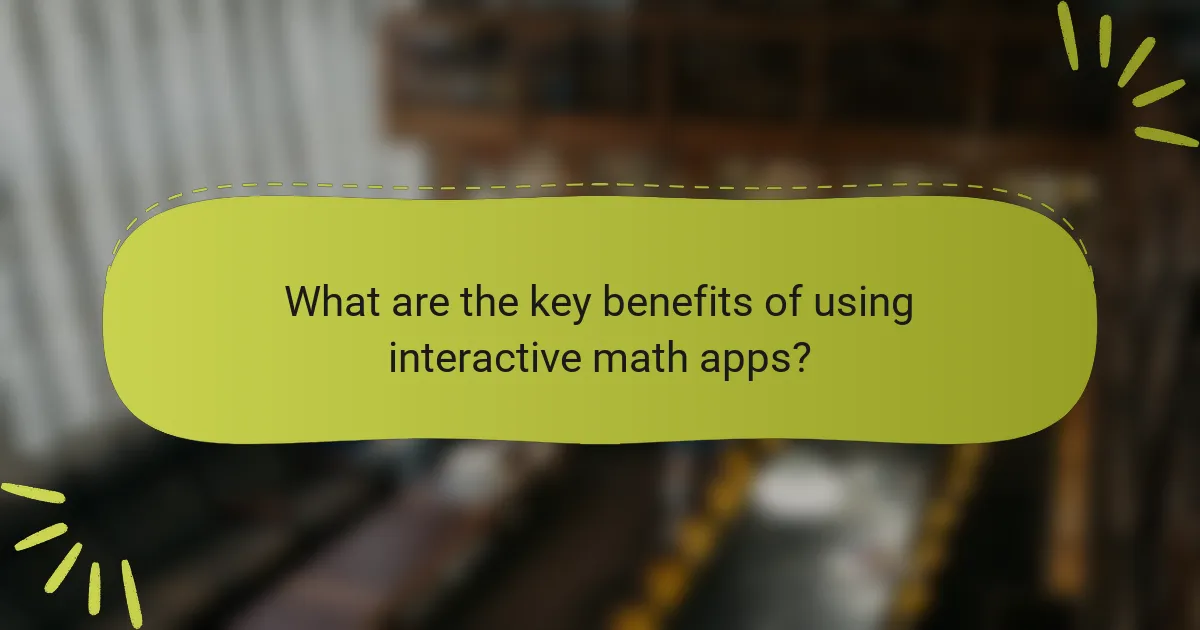
What are the key benefits of using interactive math apps?
Interactive math apps enhance learning through personalized experiences. They provide immediate feedback, allowing students to correct mistakes in real-time. This instant response helps reinforce concepts effectively. Additionally, these apps often feature adaptive learning paths tailored to individual skill levels. Research indicates that personalized learning can improve student engagement and retention. A study by the Bill & Melinda Gates Foundation found that technology-enhanced learning environments lead to better academic outcomes. Interactive math apps also include gamification elements, making learning enjoyable and motivating. This combination of fun and education encourages consistent practice. Overall, interactive math apps support diverse learning styles and foster a deeper understanding of mathematical concepts.
How do interactive math apps improve engagement in math learning?
Interactive math apps improve engagement in math learning by providing personalized and interactive experiences. These apps adapt to individual learning styles and paces, allowing students to work at their own level. Features such as gamification make learning fun and motivating. Real-time feedback helps students understand their mistakes immediately. Studies show that students using interactive apps demonstrate higher retention rates. According to a 2020 study by the National Education Association, 78% of students reported increased interest in math after using interactive apps. This combination of personalization, interactivity, and immediate feedback fosters a more engaging learning environment.
What gamification elements are commonly found in these apps?
Common gamification elements found in interactive math apps include points, badges, and leaderboards. Points reward users for completing tasks and solving problems. Badges signify achievements and milestones within the app. Leaderboards foster competition by displaying user rankings based on performance. These elements enhance user engagement and motivation. Research indicates that gamification can improve learning outcomes by making educational content more appealing. For example, a study published in the Journal of Educational Psychology found that gamified learning environments increased student motivation and performance.
How do rewards and incentives affect learning outcomes?
Rewards and incentives positively affect learning outcomes by enhancing motivation and engagement. When learners receive rewards, they often show increased persistence in tasks. Incentives can lead to improved performance as students strive to achieve specific goals. Research indicates that reward systems can boost self-efficacy in learners. A study published in the Journal of Educational Psychology found that students who received rewards for completing math tasks performed better than those who did not. This demonstrates that well-structured rewards can create a conducive learning environment. Additionally, incentives can encourage the use of interactive math apps, further enhancing personalized learning experiences.
What challenges do users face when using interactive math apps?
Users face several challenges when using interactive math apps. One significant challenge is technical issues, such as app crashes or slow loading times. These problems can disrupt the learning process and lead to frustration. Another challenge is the varying quality of content across different apps. Some apps may not provide accurate or comprehensive math concepts. Users also struggle with user interface design. Complicated navigation can hinder effective learning. Additionally, a lack of personalized feedback can limit user engagement and growth. Research indicates that 30% of users abandon apps due to poor usability. Furthermore, many users report feeling overwhelmed by the abundance of features. This can lead to confusion rather than enhanced learning. Overall, these challenges can impede the effectiveness of interactive math apps in personalized learning.
How can technical issues hinder the learning experience?
Technical issues can significantly hinder the learning experience by disrupting access to educational content. When interactive math apps malfunction, students may face delays in receiving instructions or feedback. This interruption can lead to frustration and disengagement. Connectivity problems can prevent users from accessing online resources essential for learning. Inconsistent app performance may result in lost progress or incomplete exercises. A study by the International Society for Technology in Education found that 80% of educators reported technical issues affecting lesson delivery. These issues can diminish the effectiveness of personalized learning, ultimately impacting student outcomes.
What common user frustrations arise with app usability?
Common user frustrations with app usability include navigation difficulties. Users often struggle to find features due to poor layout. Slow performance can lead to impatience and dissatisfaction. Inconsistent design elements confuse users about functionality. Lack of clear instructions frustrates new users. Frequent crashes disrupt the learning experience. Unresponsive touch controls hinder interaction. Limited customization options restrict user preferences. These frustrations can negatively impact user engagement and learning outcomes.
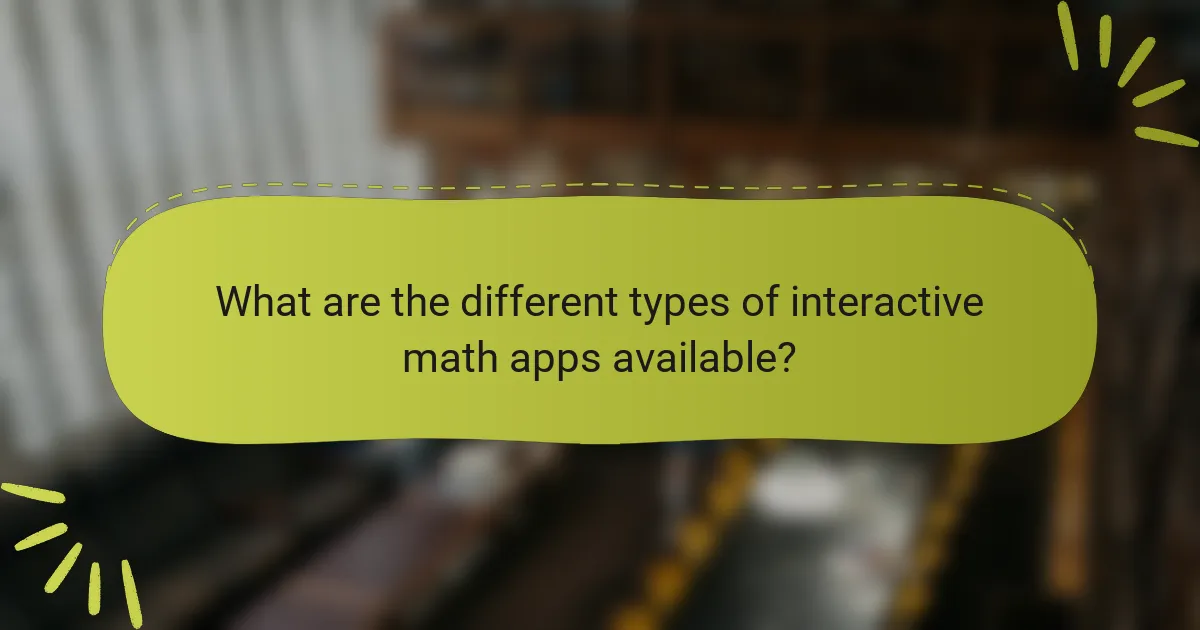
What are the different types of interactive math apps available?
Interactive math apps are categorized into several types based on their functionalities. These include problem-solving apps that help users practice specific math problems. There are also educational games that make learning math concepts engaging. Visualization apps allow users to see mathematical concepts in action through graphics. Additionally, adaptive learning apps personalize the learning experience based on user performance. Finally, collaborative apps enable students to work together on math problems in real-time. Each type serves a unique purpose in enhancing math learning.
What categories of interactive math apps exist?
Categories of interactive math apps include arithmetic, algebra, geometry, and statistics. Arithmetic apps focus on basic operations like addition, subtraction, multiplication, and division. Algebra apps help users understand variables, equations, and functions. Geometry apps explore shapes, angles, and theorems. Statistics apps teach data analysis, probability, and graph interpretation. Each category targets specific math skills and concepts, enhancing personalized learning experiences. These apps often use engaging methods like games and interactive exercises to reinforce learning.
How do educational games differ from traditional math practice apps?
Educational games engage users through interactive storytelling and challenges, while traditional math practice apps focus on drills and repetitive exercises. Educational games often incorporate elements of competition and rewards, enhancing motivation and enjoyment. Traditional math apps typically emphasize skill mastery through structured practice. Research shows that gamified learning can improve retention and engagement, making concepts more memorable. In contrast, traditional apps may lead to boredom and disengagement over time. Thus, educational games offer a more dynamic learning experience compared to traditional math practice apps.
What role do adaptive learning platforms play in personalized math education?
Adaptive learning platforms customize math education to meet individual student needs. These platforms analyze student performance in real-time. They adjust the difficulty of problems based on the learner’s skill level. This personalization helps students grasp concepts at their own pace. Research shows that personalized learning can improve student engagement and achievement. A study by the Bill & Melinda Gates Foundation found that adaptive learning tools can lead to better learning outcomes. By providing tailored feedback, these platforms guide students effectively. They ensure that each learner receives the support necessary for success in math.
How can educators effectively integrate interactive math apps into their curriculum?
Educators can effectively integrate interactive math apps into their curriculum by aligning app content with learning objectives. This ensures that the apps reinforce key concepts being taught in class. Teachers can also create lesson plans that incorporate app usage as part of daily activities. Regularly assessing student progress through the apps provides valuable data to inform instruction.
Additionally, offering training sessions for both educators and students enhances app utilization. Encouraging collaborative learning through group activities using the apps fosters engagement. Research shows that students who use interactive math apps demonstrate improved problem-solving skills. A study by Karsenti et al. (2018) found that technology integration in math education leads to higher student motivation and achievement.
What strategies can teachers use to enhance app-based learning?
Teachers can enhance app-based learning by integrating interactive features and personalized feedback. Utilizing apps that offer real-time assessments helps track student progress effectively. Incorporating gamification elements can increase student engagement and motivation. Providing opportunities for collaborative learning through app-based group activities fosters teamwork and communication skills. Setting clear learning objectives within the app ensures that students understand their goals. Regularly updating content keeps the learning experience fresh and relevant. Training teachers to effectively use these apps maximizes their potential in the classroom. Research shows that interactive learning tools improve retention and understanding of mathematical concepts.
How can assessments be aligned with app usage in the classroom?
Assessments can be aligned with app usage in the classroom by integrating app data into evaluation criteria. Educators can track students’ progress through the app’s analytics features. This data provides insights into individual learning patterns and areas needing improvement. Aligning assessment methods with app usage allows for personalized feedback. For instance, quizzes can be designed based on the app’s content. Additionally, performance metrics from the app can inform traditional assessments. This approach ensures that assessments reflect actual student engagement and understanding. Research shows that this method enhances learning outcomes by tailoring instruction to student needs.
What are best practices for selecting interactive math apps for students?
Best practices for selecting interactive math apps for students include evaluating educational content, user engagement, and adaptability. Educational content should align with curriculum standards. Apps must provide clear explanations and practice opportunities for various math concepts. User engagement is crucial; apps should be visually appealing and interactive. Features like gamification can enhance motivation. Adaptability is important; apps should adjust to individual learning paces. Research shows personalized learning can improve student outcomes. The effectiveness of interactive apps is supported by studies indicating increased student engagement and understanding in math.
What criteria should be considered when evaluating math apps?
When evaluating math apps, consider usability, educational content, engagement, adaptability, and feedback mechanisms. Usability refers to how intuitive and user-friendly the app interface is. Educational content should align with curriculum standards and provide clear explanations. Engagement is crucial; the app should include interactive elements to maintain user interest. Adaptability ensures that the app can cater to different learning paces and styles. Feedback mechanisms should provide instant responses to user input, promoting learning through correction and reinforcement. These criteria help ensure that math apps effectively support personalized learning and practice.
How can parents support their children in using these apps effectively?
Parents can support their children in using interactive math apps effectively by establishing clear guidelines for usage. They should set specific times for app use to create a routine. Parents can also engage with their children during app sessions. This involvement helps clarify concepts and encourages discussion. Monitoring progress within the app allows parents to identify areas needing improvement. Providing positive reinforcement can motivate children to continue learning. Additionally, parents should explore app features together, maximizing the learning experience. Research shows that parental involvement enhances children’s academic performance, making these strategies beneficial.
Interactive math apps for personalized learning and practice are digital tools designed to enhance students’ math skills through tailored educational experiences. These apps utilize features such as adaptive learning paths, instant feedback, and gamification to engage users and improve retention. The article explores how these apps adapt to individual learning styles, the importance of practice in mastering math concepts, and the various types of apps available. It also addresses the challenges users may face and offers strategies for educators and parents to effectively integrate and support the use of these apps in learning environments. Key benefits include improved student engagement, understanding, and academic performance through personalized learning approaches.
